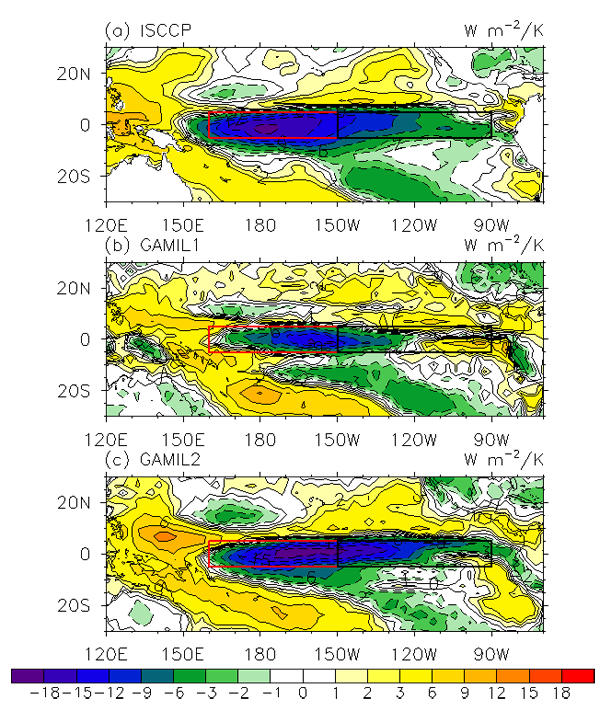The shortwave cloud radiative forcing (SWCF) feedback ( ) in the Equatorial Pacific is one of the dominant components of negative heat flux feedbacks that drive the El Ni?o-Southern Oscillation (ENSO) evolution. However, it is poorly reproduced by most of the models participating in the Coupled Model Intercomparison Project Phases 3 and 5 (CMIP3 and CMIP5), with weak amplitude and even wrong sign. Recently, a notable improvement on the SWCF feedback simulation has been achieved by the Flexible Global Ocean-Atmosphere-Land System Model, Grid-point version 2 (FGOALS-g2), a CMIP5 climate system model developed by scientists in Institute of Atmospheric Physics. Exploring the causes of such striking advance in FGOALS-g2 will help us understand the source of
) in the Equatorial Pacific is one of the dominant components of negative heat flux feedbacks that drive the El Ni?o-Southern Oscillation (ENSO) evolution. However, it is poorly reproduced by most of the models participating in the Coupled Model Intercomparison Project Phases 3 and 5 (CMIP3 and CMIP5), with weak amplitude and even wrong sign. Recently, a notable improvement on the SWCF feedback simulation has been achieved by the Flexible Global Ocean-Atmosphere-Land System Model, Grid-point version 2 (FGOALS-g2), a CMIP5 climate system model developed by scientists in Institute of Atmospheric Physics. Exploring the causes of such striking advance in FGOALS-g2 will help us understand the source of  biases and further improve it.
biases and further improve it.
To elucidate the  biases, many studies have focused on convective parameterization scheme and its individual processes, such as closure assumption and momentum transport, tuning parameters and model resolution in AGCMs, however, the importance of non-convective condensation processes, cloud-related processes, has not received much attention. Li Lijuan et al. found that the improvement of the SWCF feedback in FGOALS-g2 is mainly from its atmospheric component GAMIL2 (Fig.1), but is closely associated with the enhanced non-convective condensation processes. The physical mechanism is that the enhanced stratiform condensation and evaporation in GAMIL2 play a key role in improving the simulations of multi-year annual mean water vapor (or relative humidity), cloud fraction and in-cloud liquid water path (ICLWP) and hence in reducing the biases of SWCF responses to El Ni?o.
biases, many studies have focused on convective parameterization scheme and its individual processes, such as closure assumption and momentum transport, tuning parameters and model resolution in AGCMs, however, the importance of non-convective condensation processes, cloud-related processes, has not received much attention. Li Lijuan et al. found that the improvement of the SWCF feedback in FGOALS-g2 is mainly from its atmospheric component GAMIL2 (Fig.1), but is closely associated with the enhanced non-convective condensation processes. The physical mechanism is that the enhanced stratiform condensation and evaporation in GAMIL2 play a key role in improving the simulations of multi-year annual mean water vapor (or relative humidity), cloud fraction and in-cloud liquid water path (ICLWP) and hence in reducing the biases of SWCF responses to El Ni?o.
Reference: Lijuan Li*, Bin Wang, and Guang J. Zhang, 2014: The Role of Nonconvective Condensation Processes in Response of Surface Shortwave Cloud Radiative Forcing to El Ni?o Warming. J. Climate, 27, 6721–6736.
Link: http://journals.ametsoc.org/doi/abs/10.1175/JCLI-D-13-00632.1

Fig. 1 Response of surface shortwave cloud radiative forcing (SWCF) to Ni?o 3 index for (a) ISCCP, (b) GAMIL1 and (c) GAMIL2 as measured linear regression coefficients (W m-2/K). Ni?o 3 index is defined as the Ni?o-3 sea surface temperature anomaly. Bold red and black rectangles represent Ni?o 4 and Ni?o 3 regions, respectively.
